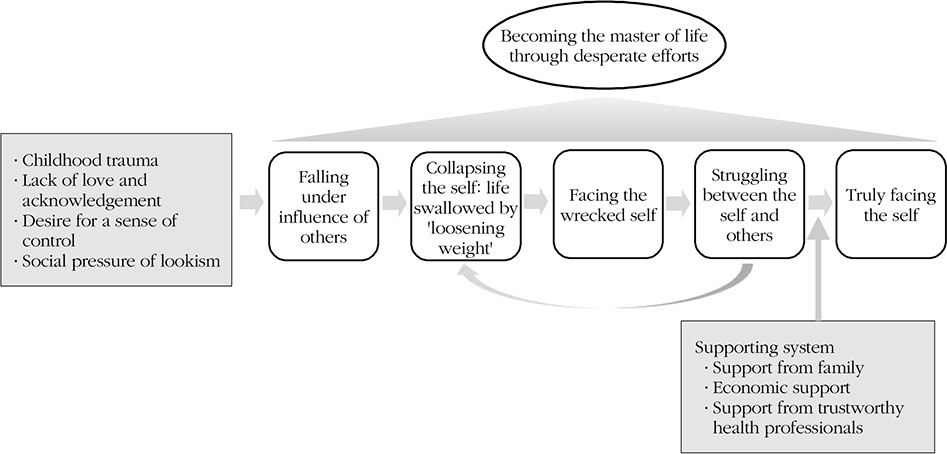Korean J Adult Nurs.
2015 Dec;27(6):695-706. 10.7475/kjan.2015.27.6.695.
Disease Experience of Korean Women with Eating Disorders
- Affiliations
-
- 1Department of Nursing, College of Health Sciences, Cheongju University, Cheongju, Korea. dhan@cju.ac.kr
- KMID: 2221723
- DOI: http://doi.org/10.7475/kjan.2015.27.6.695
Abstract
- PURPOSE
This study was aimed to explore and describe the disease experience of Korean women with eating disorders within psychological and sociocultural context.
METHODS
The participants were 12 young adult women suffering with eating disorders or have recovered from the diseases. Data were collected via in-depth interviews and analyzed according to the grounded theory methodology by Strauss and Corbin.
RESULTS
The core category of the disease experience was 'becoming the master of life through desperate efforts'. The disease experience was categorized into five different phases including 'falling under the influence of others', 'collapsing the self: life swallowed by loosening weight', 'facing the wrecked self', 'struggling between the self and others', 'truly facing the self'. The intervening conditions were various supporting systems such as 'support from family', 'economic support' and 'support from trustworthy health professionals'.
CONCLUSION
The findings of this study indicate that it is necessary to develop nursing interventions to support women with eating disorders and alleviate their suffering from eating disorders. Also specialized educational programs are warranted to prevent the eating disorders, and to reduce social stigma of eating disorders.
MeSH Terms
Figure
Reference
-
1. American Psychiatric Association. Diagnostic and statistical manual of mental disorder. 3rd ed. Washington, DC: American Psychiatric Association;1994.2. Health Insurance Review & Assessment Service. Report material of Eating disorders [Internet]. Seoul: Health Insurance Review & Assessment Service;2013. cited 2013 May 24. Available from: http://www.hira.or.kr.3. Stice E, Marti CN, Rohde P. Prevalence, incidence, impairment, and course of the proposed DSM-5 eating disorder diagnoses in an 8-year prospective community study of young women. Journal of Abnormal Psychology. 2013; 122(2):445–457. DOI: 10.1037/a0030679.
Article4. Arcelus J, Mitchell AJ, Wales J, Nielsen S. Mortality rates in patients with anorexia nervosa and other eating disorders-a meta-analysis of 36 studies. Archives of General Psychiatry. 2011; 68(7):724–731. DOI: 10.1001/archgenpsychiatry.2011.74.5. Lee HH. A study of convergence in Korean food culture. DONG ASIA KODAEHAK: The East Asian Ancient Studies. 2010; 23:475–502.6. Bae JH, Choi JY. A study on psychological characteristics of eating disorders: a comparison with restrained, unrestrained (normal) eaters, and overweighters. he Korean Journal of Clinical Psychology. 1997; 16(2):209–217. DOI: 10.1002/erv.2373.7. Kong SS. A study on eating disorder symptoms and depression of normal female and female with eating disorders. Journal of Soonchunhyang Medical College. 2004; 10(3):2031–2038.8. Daniel S, Lisa RL, Prudence CW, Marsha DM. Attempted suicide and self-injury in patients diagnosed with eating disorders. Comprehensive Psychiatry. 2004; 45(6):447–451.
Article9. Grave RD, Calugi S, Doll HA, Fairburn CG. Enhanced cognitive behaviour therapy for adolescents with anorexia nervosa. Behaviour Research and Therapy. 2013; 51:R9–R12. DOI: 10.1016/j.brat.2012.09.008.10. Godart N, Berthoz S, Curt F, Perdereau F, Rein Z, Wallier J, et al. A randomized controlled trial of adjunctive family therapy and treatment as usual following inpatient treatment for anorexia nervosa adolescents. PLoS ONE. 2012; 7(1):e28249. DOI: 10.1371/journal.pone.0028249.
Article11. Keski-Rahkonen A, Tozzi F. The process of recovery in eating sufferers' own words: an internet-based study. The International Journal of Eating Disorder. 2005; 37:S80–S86.12. Patching J, Lawler J. Understanding women's experiences of developing an eating disorder and recovering: a life-history approach. Nursing Inquiry. 2009; 16(1):10–21.
Article13. Strauss AL, Corbin J. Basics of qualitative research: techniques and procedures for developing grounded theory. 2nd ed. NewDeli: Sage;1998.14. Corbin J, Strauss AL. Basic of qualitative research: techniques and procedures for developing grounded theory. 3rd ed. Thousand Oaks, CA: Sage;2008.15. Morse JM, Stern PN, Corbin J, Bowers B, Charmaz K, Clarke AE. Developing grounded theory: the second generation. California: Left Coast Press;2009.16. Sandelowski M. The problem of rigor in qualitative research. Advances in Nursing Science. 1986; 8:27–37. DOI: 10.1097/00012272-198604000-00005.
Article17. Blumer H. YS Park . Symbolic interactionism. Seoul: Kachi;1982.18. Hwang RH. A study on eating disorder, body image and selfesteem of female university students. Korean Journal of Women Health Nursing. 2009; 15(4):328–335. DOI: 10.4069/kjwhn.2009.15.4.328.
Article19. Wonderlich SA, Crosby RD, Mitchell JE, Thompson KM, Redlin J, Demuth J, et al. Relationship of childhood sexual abuse and eating disturbance in children. Journal of the American Academy of Child and Adolescent Psychiatry. 1997; 36(8):1107–1115.
Article20. Hewitt JP. IJ Yoon . Self and society: a symbolic interactionist social psychology. Seoul: Hakjisa;2001.21. Kim SY, Baek KY, Seo YS. Roles of interpersonal sexual objectification experiences and internalization of standards of beauty in eating disorder symptomatology: a test and extension of objectification theory with dance majors. The Korean Journal of Women Psychology. 2010; 15(4):613–634.22. Kim JS, Lee MS. The effect of TV media on adolescent body image. Journal of the Korean Society of Clothing and Textiles. 2001; 25(5):957–968.23. Becker AE, Burwell RA, Herzog DB, Hamburg P, Gilman SE. Eating behavior and attitudes following prolonged exposure to television among ethnic Fijian adolescent girls. British Journal of Psychiatry. 2002; 180(6):509–514.24. Tresure J. HC Kang SJ Park . Anorexia nervosa: a survival guide for families, friends and sufferers. Anyang: Academia;2009.25. Lazarus RS, Folkman S. Stress, appraisal, and coping. New York: Springer;1984.26. Tozzi F, Sullivan PF, Fear J, Mckenzie J, Bulik CM. Causes and recovery in anorexia nervosa: the patient's perspective. International Journal of Eating Disorders. 2003; 33(2):143–154. DOI: 10.1002/eat.10120.
Article27. Sohn SS. Familism and social conspicuousness in Korea. Discourse 201. 2006; 9(2):245–274.28. Ronel N, Libman G. Eating disorders and recovery: lessons from overeaters anonymous. Clinical Social Work Journal. 2003; 31(2):155–171.29. Park YW. Eating disorder. Korean Journal of Family Medicine. 2000; 21(3):315–324.30. Tedeschi RG, Calhoun LG. Trauma and transformation: growing in the after math of suffering. Thousand Oak, CA: SAGE;1995.
- Full Text Links
- Actions
-
Cited
- CITED
-
- Close
- Share
- Similar articles
-
- Detecting and Treating Eating Disorders in Diabetic Patients
- Medical complications and management of eating disorders
- Factors associated with Multi-impulsivity in Women Patients with Eating Disorders
- Obesogenic Behavior and Binge Eating Disorder in an Elderly Female with Schizophrenia
- The Therapeutic Implications of Alexithymia in Patients with Eating Disorders


